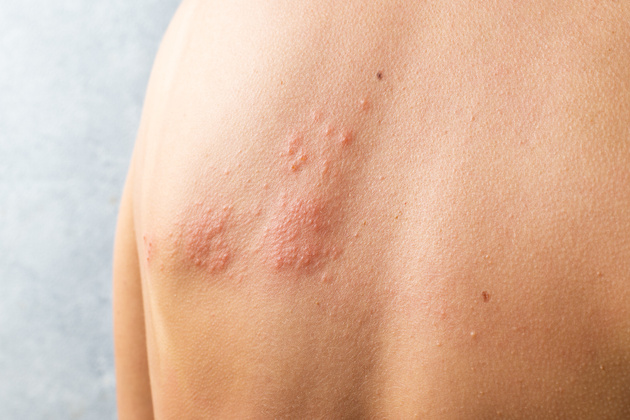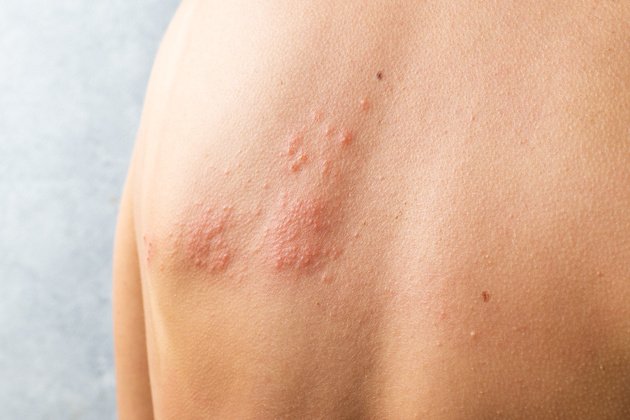Shingles: What is it, Causes, Symptoms and Treatment
Herpes zoster disease, also known as shingles, is a viral disease that occurs when the varicella zoster virus, which is dormant in some nerve roots after chickenpox, is triggered due to various reasons.

Herpes zoster disease, also known as shingles, is a viral disease that occurs when the varicella zoster virus, which is dormant in some nerve roots after chickenpox, is triggered due to various reasons.
The underlying mechanism in the formation of shingles is generally the negative impact of the functions of the person’s immune system. Shingles is a rare condition in people with a strong immune system. This disorder, which can have a malignant course, can present itself with many different symptoms.
What is Shingles?
It is a secondary infection caused by Varicella Zoster Virus and usually presents with vesicular lesions limited to a certain area. This virus; In childhood and other young age groups, it causes a disease called chickenpox at first encounter. Once chickenpox is over, viruses can remain dormant in the nervous system for years. Shingles is a disease caused by the reactivation of dormant viruses. Shingles, one of the diseases caused by viruses, is characterized by a red skin rash and blisters that cause pain and burning sensation.
The resulting rash generally tends to occur on one half of the body, and the trunk, neck and face are the body areas where symptoms of the disease occur most frequently. Cases of shingles tend to regress in approximately 2-3 weeks.
What Causes Shingles?
Shingles can occur at any age, although it is more common over the age of 50. About half of people over the age of 80 have had shingles at least once in their lifetime. The chickenpox vaccine did not reduce the incidence of shingles. The majority of patients do not have any immune problems. However, it is more common in people with suppressed immune systems.
Shingles may recur, although this is rare. A second attack occurs in approximately 4% of patients. Shingles recurrences are more common, especially in people with suppressed immune systems.
Shingles disease occurs as a result of the reactivation of dormant viruses. It causes regional inflammation and rash development in the skin area where the nerve on which it is located is effective. Pain is felt through nerve cells affected by inflammation in this area.
There are many factors that can trigger shingles:
- emotional stress
- Diabetes
- Use of drugs with immunosuppressant properties (cortisone therapy, etc.)
- Long-term (chronic) conditions
- Having an underlying cancer disease
- Radiotherapy and surgical interventions
The real reason why shingles occurs repeatedly has not yet been fully revealed. Various conditions, especially those affecting the person’s immunity, are considered to be one of the most important factors in the recurrence of shingles. In individuals who receive chemotherapy and radiation therapy within the scope of treatment planning for cancer disease, body defenses are negatively affected and shingles may occur. Individuals with AIDS disease caused by the HIV virus, people who have received an organ transplant and use immunosuppressive drugs to prevent rejection, and people who use high doses of corticosteroid drugs are in the group where the immune system is negatively affected.
While it is generally limited to a certain location and less painful in otherwise healthy people, the disease is more severe in elderly patients and people with suppressed immune systems.
What are the symptoms of shingles?
Shingles disease first manifests itself with complaints such as fever, headache and fatigue. In the area where shingles will break out, there will first be abnormal skin sensations such as itching, stinging, and sometimes pain. During this period, it may be confused with conditions that may cause pain, such as muscle pain, heart pain, kidney pain, appendicitis, and migraine. Following these symptoms, painful and edematous red bumps appear within 3-5 days, and soon small blisters develop in the form of groups. A burning sensation is evident in these rashes.
It is most often affected in the thorax region (upper body) in young people, in the sacral region (coccyx) in older women, and around the eyes in older men.
It is typical for lesions to be accompanied by pain, sometimes with a piercing character. The pain is mild in young people, sometimes it may not be present at all. In the elderly, pain is almost always present and severe.
In individuals with a normal immune system, all lesions regress within 2-4 weeks. There is usually no scar left in the place of regressed lesions. The pain usually tends to regress along with the rash. However, sometimes persistent and chronic pain, which we call postherpetic neuralgia, may occur. In this case, treatments recommended by Neurology or Algology specialists may be useful.
We can list the risk factors for the development of postherpetic neuralgia as follows:
- Appearing at an older age
- Severe pain before and when the lesions first appear
- intense rash
- Head and coccyx region involvement
Shingles can affect the face, eyes, back and hip area:
Shingles Occurring on the Face and Eyes
Although shingles is a disorder that usually occurs in a part of the trunk and back, it can also affect the face unilaterally. The majority of these cases are elderly men. Care should be taken, especially as lesions occurring on the face close to the ear may progress to serious health problems such as hearing loss and affecting the facial muscles.
Shingles that occur around the eyes is called ophthalmic herpes zoster and is a condition that affects approximately 10% of individuals with this condition. Various problems such as stinging, pain, burning, edema and blurred vision may occur due to rashes on the upper parts of the eyelids, forehead and nose. If the feeling of pain in the eye continues after the rash disappears, it depends on the nerves related to the eye being affected during the disease. This pain sensation may decrease over time.
If eye shingles is not treated, serious conditions such as long-term vision loss and permanent damage to the cornea may occur. It is recommended that shingles patients with eye-related symptoms be aware of these symptoms and seek medical support as soon as possible. Starting treatment within the first 72 hours following the occurrence of symptoms is one of the first steps that can be taken to prevent undesirable negative situations.
It is quite typical to have a rash covering the eyes and their surroundings on one half of the face and extending to the top of the scalp, along with eye closure due to severe edema. The rash may be accompanied by lymph node swelling in front of the ear.
The ear, like the eye, is another sensory organ that can be affected due to shingles. Symptoms such as hearing loss, intense pain in one ear, dizziness and loss of taste are among the characteristics of a disease called Ramsay Hunt Syndrome, which occurs due to shingles in the ear, and this situation is important because it requires urgent treatment.
Facial shingles regresses longer than body shingles, which takes an average of 2-4 weeks.
Shingles lesions that occur in the mouth area can be quite painful. These lesions also make it difficult for the person to feed.
Shingles Occurring on the Back and Hips
Shingles rash tends to occur around the upper body and waist area. Shingles lesions on the back appear in a line on one side of the lower back area. Apart from the back area, shingles lesions can also occur in the hip area of the person. Unlike other areas, lesions on the buttocks may cause sudden itching, tingling and pain.
Is Shingles Contagious?
Classic, limited shingles lesions are less contagious. Transmission through droplets in chickenpox is not an expected situation in shingles. However, since the viruses contained in active blisters are contagious, transmission through contact can rarely occur. Once the lesions dry and crust over, the contagion disappears completely.
If Varicella Zoster Virus is transmitted to individuals who have not previously encountered this virus, it may result in the development of chickenpox in these individuals.
Since the transmission of Varicella Zoster Virus may occur after contact with the contents of the lesions that occur during the disease, it is recommended not to contact the lesions and to pay attention to hand hygiene.
Shingles patients should especially avoid being around people who are immunocompromised or pregnant.
How to Diagnose Shingles?
The diagnosis of shingles is generally made in the light of the typical lesions and clinical symptoms caused by this disease. There are also some tests that can be used when diagnosis is difficult. Tzanck test is a test that describes the examination of the fluid in the lesions under a microscope and the detection of multinucleated giant cells. Another diagnostic method that can be used to diagnose shingles is to determine the level of antibodies formed against this virus in the person. PCR test is the most reliable test for the diagnosis of shingles, and with this test, it can be examined whether there is genetic material of the virus in the person’s lesions.
Shingles Treatment
In the treatment of shingles, antiviral drugs containing the active ingredient Acyclovir/Valacyclovir/Brivudin are prescribed, and following the use of these drugs, the regression of the lesions is accelerated and the feeling of pain can be controlled. Apart from antiviral drugs, anti-inflammatory drugs can be used to control pain and edema. In case of long-term and severe pain, narcotic painkillers, anti-seizure drugs and anesthetic drugs that can be applied to the skin may be prescribed by physicians. Antihistamine group drugs are effective in relieving the itching that occurs in shingles.
Shingles is a disease that tends to improve within a few weeks. If there is no improvement in symptoms and complaints within 10 days despite treatment, it is recommended that you consult your doctor again.




You could never find the words to describe how much I loved you. No matter how beautiful the picture is or how polished your writing is, you read it quickly. To be honest, I think you should give it another chance soon. I will probably try to go on this hike again and again if you make sure it is safe.